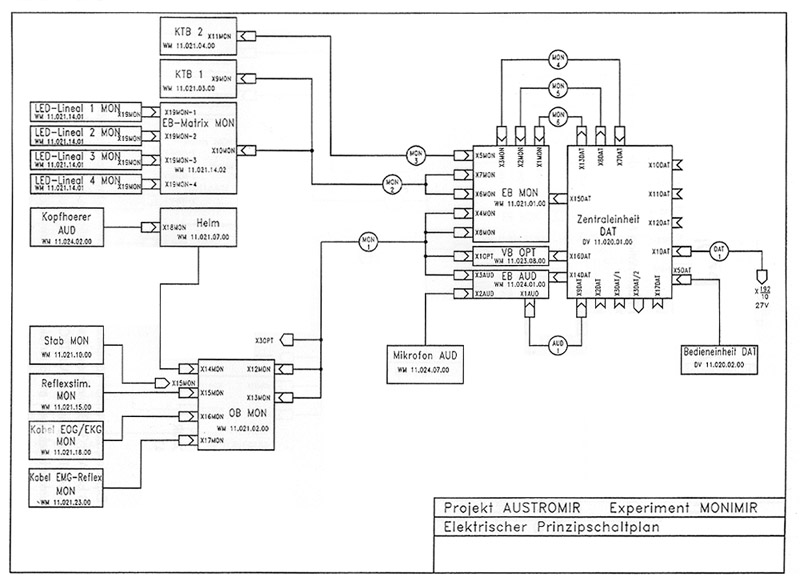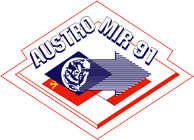Arm, eye or head movements are, from a neurological point of view, very complex procedures. The brain must constantly compare incoming information with outgoing commands in order for a movement to perform smoothly. The messages from the peripheral sensors (receptors stored in the joint capsules, muscle and sinews form fine tactile sensors and send constant information to the central nervous system) give information about the condition of the extremities, about the muscle and sinew pressure. They can perceive if the next planned movement is even possible. Commands from the central nervous system go back to the periphery, that is, to the hand or eye, in a constant feedback mechanism.
Movements are therefore complex, in such a way that man can perform movements in more than one form. He can move towards a target either pre-programmed or briskly, or he can follow a given external action slowly.
Objectives
Weightlessness changes the messages of the sensor systems to the brain, and especially, it drastically reduces the information flow of the equilibrium organ as a result of the missing gravity. Less information comes from the muscles, joints and ligaments because the muscular activity is also minimal. Even the skin notifies the brain less, because the sole of the foot and the backside are rarely stimulated, and clothing barely touches the body. Eye and ear are similarly strong when they are kept busy on earth. They should have an important control function by changes, for example, the definition or “up” or “down” in weightlessness has no meaning for the eye. The effect of weightlessness on bearing and position reflexes was examined.
Generally, MONIMIR and the accompanying experiments COGIMIR, OPTOVERT and AUDIMIR incorporated detailed neuro-psychological examinations in space flight.
Functionality, Measuring principle
The cosmonaut had to perform head and arm movements in a given schema. These movements were recorded with a video camera and analyzed back on earth. Three types of movements (arm, eyes, and head) were individually collected and their coordination was also compared between them. A quick glance, for example, the movement of the arm, mostly resulted with a head movement. These reflexes go out from the brain stem. Exactly defined optical and acoustical signals that the cosmonaut had to follow, allowed for standardized movements in all task positions. The movements of the cosmonaut’s arms were registered with the help of an infrared pistol. He had to hit a tablet equipped with LED’s when it illuminated (using the random principle controlled by the DATAMIR computer). The movements of the pistol were collected with the infrared camera system. Eye movement was concurrently measured using an electro-oculogram.
Two cameras measured the head movement. They followed the movements of infrared LED’s placed on the experimental helmet of the cosmonaut. The direction of the helmet/head was followed with the help of a lamp on the helmet that projected a ray of light on the LED tablet.
The acoustical signals were measured with a pair of headphones placed in a predetermined angle on a horizontal level. The cosmonaut tried to target the right direction.
The examination of the cooperation between short-term memory and movement was done by making the cosmonaut learn a set of moves, and finally try to repeat them with his eyes closed. As he had no control though the eye, he relied only on the information that he received from the joint receptors.
The knee-jerk gave information about the activity grade on the sensomotor systems. It was measured through the hammer blow test. The neck reflexes in the muscles and the joints of the upper cervical spine were determined with sensors. They showed the position as well as the movement of the head against the body. Changes resulting from weightlessness can cause interferences of the messages from the cervical spine to the body. The movements of the cervical spine were therefore collected. Consequently, the messages from the brain system could be compared with the messages from the remaining parts of the body.
Shared equipments of the Austrian payload
DATAMIR, AUDIMIR, OPTOVERT, MOTOMIR
Results
In the first part of the examinations, the cosmonaut targeted an acoustic stimulus, whereby the movement characteristics of the eyes, head and the right arm were analyzed and compared. This necessitated adequate afferent information. The exactness of the performed movement was determined by how much related information was sent from the sensors to the central nervous system. This occurred at the programming stage as well as at the execution stage.
In a closed state, the eyes depend solely on the proprio receptors that relay internal body information. In this case, the messages of the eye muscles regarding the position of the eyes. The proprio receptive apparatus of the eye muscles cannot determine the exactness of the movement: The eyes of the cosmonaut missed the target considerably. The movements of the head and the arms were more exact, whereby the movements of the head did not reach the same precision that would have been expected back on earth. The movements of the arm were also controlled with an optical control but the result did not change. The decrease of the exactness in the movements during the flight confirmed the leading role of the proprio receptors in weightlessness.
MONIMIR could quantitavely describe the process of adaptation of the vestibulo-ocular systems (i.e. the interaction between the equilibrium organ and the eyes) in weightlessness. This was carried out through the analysis of the target movements through optical stimulus. The results of the experiments showed that weightlessness quickly leads to a modification of the regulation mechanisms of head and arm movements: The required exactness of the movement will be reached through a considerable increase in the duration of the movement.
The movements of the head and arm following a moving light signal were performed constantly and exactly, as if performed under the same conditions on earth. The gravitation-independent optical system apparently compensates for the inadequate information of the remaining sensor systems. Adaptation was observed through the pre-programmed characteristics of movements within the framework of the motor short-term memory tests. However, this was not the case for movements which were performed without an optical control.
The effect of the neck proprio receptors through head rotation as well as the sideward’s declination of the head, contrary to terrestrial conditions, led to a change in the horizontal arm movement, in particular, a displacement of the movement path. This was considered as another confirmation in the development of body schema disruptions.
The examination of the spinal reflex mechanisms by means of the reflex stimulator knee-jerk showed a hyper-reflex with a distinct decrease of the stimulus threshold and an increase of the reflex. Finally, the analysis of the three-dimensional movement flow of the head showed changes in the bio-mechanics of the cervical spine from the beginning of the flight and the consequent adaptation. One can deduce that this leads to a change of the information flow from the upper cervical spine sensors, and possible reasons for space sickness.
Practical application
Application ranges
Diagnostics and therapy checkup of patients in the neurology, orthopedy, accident medicine, sport- and rehabilitation medicine
Application target
- Early diagnostics of diseases of the musculoskeletal system and nervous system
- Checkup of the therapy and medical rehabilitation measures
- Effectiveness checkup of tonus-pressing preparations (Antispastika)
Direct interested institutions on the utilization of the experiment results
- University Clinic for Neurology, Innsbruck
- University Clinic for Neurology, Messina
- University Clinic for Psychiatry, Charite, Berlin
- Institute for Biomedical Problems, Moscow
- University Clinic for Neurology, Moscow
- University Clinic for Rehabilitation, Prague
Technical characteristics
The equipment MONIMIR consisted of the following units

Electronic box with cables
This unit was installed in the central unit of the system DATAMIR, the connecting cables to DATAMIR MON4, MON5, MON6 were supplied allready mounted.
| Mass: | 2.0 kg |
| Dimensions: | 251 mm x 142 mm x 129 mm |
| Power input: | 20 W |
Aluminium container with additional- and reserve devices
- Operator box (OB MON) with the pre-amplifiers for the electro-physiological signals
- CCD – Video camera KTB1
- Fixing device for KTB1
- CCD – Video camera KTB2
- Fixing device for KTB2
- Helmet top with a show lamp and 5 twosomes of infrared diodes
- Headset as fixing for the fixing device on the head of the subject
- Light-emitting diode array elektronic box (EB-Matrix MON)
- Reserve lamp helmet/beam
- Reserve fuses
| Mass: | 7.6 kg |
| Dimensions: | 545 mm x 360 mm x 150 mm |
Cloth bag 1 with equipment components
- Beamer with light and 5 Infrared LEDs
- Reflexstimulator
- LED matrix ruler (4 pieces) with each 7 LEDs
- LED matrix coverage (4 pieces) to compose a color coordinated matrix background
| Mass: | 5.7 kg |
| Dimensions: | 535 mm x 240 mm x 190 mm |
Cloth bag 2 with equipment components
- Cable MON1 (connection electronic box – operator box)
- Cable MON2 (connection electronic box – video camera KTB1)
- Cable MON3 (connection electronic box – video camera KTB2)
- Electrode cable EMG
- Electrode cable EOG/EKG
- Electrode cable EMG for reflex stimulation
- Set of electrodes (100 pieces)
- Set of cleaning tissues
- Set of fixation sleeves for the electrode cable (4 pieces)
- Shirts MONIMIR/MOTOMIR
- Belt to fix the operator box at the subject
- Belts to fix the subject (3 pieces)
| Mass: | 5.1 kg |
| Dimensions: | 510 mm x 235 mm x 170 mm |
Experimenters
Medicine:
o. Univ.-Prof. Dr. Franz Gerstenbrand (institute manager)
Univ.-Doz. Dr. Meinhard Berger (project manager)
Dr. Armin Muigg
Dr. Lorenza Grill
Dr. Elisabeth Karamat
Dipl.-Ing. Mario Ostermann
all: University Clinic for Neurology, Innsbruck
Technics:
Dipl.-Ing. Dr. Massud Mossaheb (project manager)
Dr. Gerhard Holzmueller
Ing. Erwin Baldauf
all: FDP, Company Fanak Data Processing Ges.m.b.H., Vienna
Sub-contractor:
o. Univ.-Prof. Dipl.-Ing. Dr. Erwin Hochmair (institute manager)
Mag. Georg Steinwender
all: Institute for Applied Physics from the University Innsbruck
Ing. Walter Bumba
Ing. Christian Wieland
all: Company Ing. Walter Bumba, Vienna
